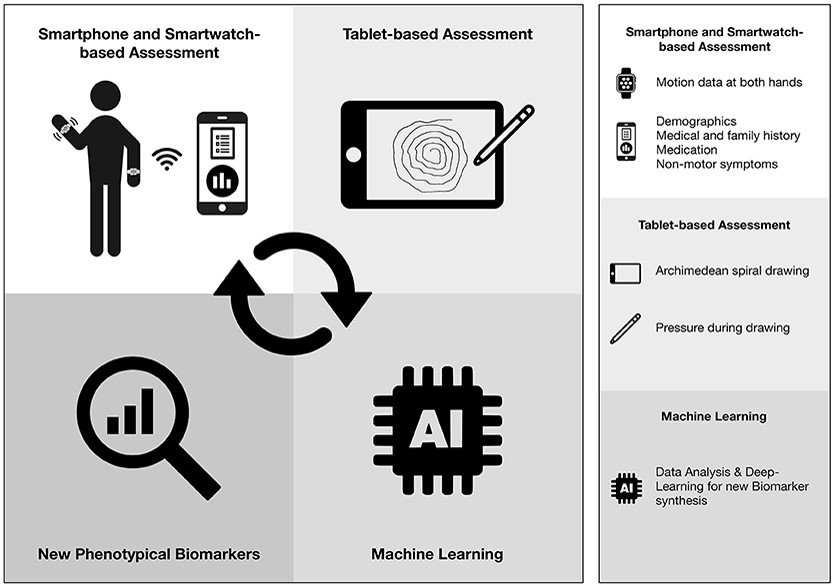Improved research on early diagnosis.
Objective Movement Analysis and Deep Phenotyping
In Parkinson’s disease, there is a strong need for new biomarkers, complementing standard procedures as clinical assessment or advanced imaging [1]. Clinical assessment is limited by human vision and may not identify subtle pathologies and imaging is costly, invasive, lacks availability and is not suitable for small changes in the disease course [2].
Establishing a technology-driven two-year prospective study, we implemented a novel mobile system using two synchronous smartwatches at each patient’s wrists in an easy-to follow neurological assessment while the patient is seated in an arm-chair [3,4]. The smartwatches are paired with one examination smartphone, which guides the examiner through the assessment step by step. In addition, electronic questionnaires are implemented to establish a checklist of important early signs of Parkinson’s or other movement disorders and to ask for existing medication.
The system is connected to a German research database with real-time analysis options and highest standards for data privacy.
The aim of the system is to establish a framework to
Enable mobile Health Technologies in Neurology with objective measurements including Tremor, Bradykinesia, Dyskinesia and many other phenotypical characteristics
Integration and Analyses of Medical History & Non-Motor Symptoms (fatigue, anxiety, sleep disorders, weight change, sexual problem etc)
Utilize state of the art Machine Learning for Biomarker Analyses and improved research on early diagnosis and treatment monitoring

Information Flow
The system currently supports voice, speech and gait analyses and tablet-based assessment for all types of movement disorders spiral drawing. will enable Deep Phenotyping with enormous potential for composite biomarkers analyses. A multicentre study is planned to research on this new endeavour.
References
[1] Rizzo G, Copetti M, Arcuti S, Martino D, Fontana A, Logroscino G. Accuracy of clinical diagnosis of Parkinson disease: A systematic review and meta-analysis. Neurology 2016; 86(6):566–76.
[2] Espay AJ, Bonato P, Nahab FB, Maetzler W, Dean JM, Klucken J, Eskofier BM, et al. Technology in Parkinson’s disease: Challenges and opportunities. Mov Disord 2016; 31(9):1272–82.
[3] Varghese J, Niewöhner S, Soto-Rey I, Schipmann-Miletić S, Warneke N, Warnecke T, et al. A Smart Device System to Identify New Phenotypical Characteristics in Movement Disorders. Frontiers in neurology. 2019;10:48.
[4] Varghese J, Fujarski M, Hahn T, Dugas M, Warnecke T. The Smart Device System for Movement Disorders: Preliminary Evaluation of Diagnostic Accuracy in a Prospective Study. Stud Health Technol Inform. 2020 Jun 16;270:889–93.